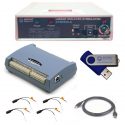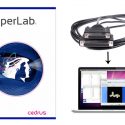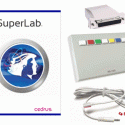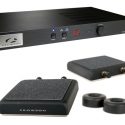Search
This Application Note details setup and measurements for Auditory Brainstem Response (ABR) measurements using an MP160/MP150 data acquisition system and AcqKnowledge 4.1 or above software. Whenever a sound wave is detected…
Showing 4 of 100 products
MP System (MP160, MP150, MP100) stimulation features provide a powerful vehicle for outputting a variety of wave shapes of varying duration, coincident with the data acquisition process. This application note…
MP150 and MP100 System stimulation features provide a powerful vehicle for outputting a variety of waveforms of varying duration, coincident with the data acquisition process. Often, a stimulation voltage in…
This application note explains how to record electrodermal activity (EDA/GSR) and observe electrodermal response (EDR) changes with the EDA100C Electrodermal Activity amplifier, GSR100C Galvanic Skin Response amplifier, or TEL100C telemetry…
The following application note will describe how to use the AcqKnowledge software to create Arbitrary waveforms for the STM100C Stimulator Module. We recommend that you use this application note in…
Generally considered, if the transducer is able to be used in the MRI (see BIOPAC MRI Use declarations), the transducer signal can be relatively easily recorded during an MRI scan (an MRI…
For Magnetic Resonance Imaging (MRI) applications, it can be important to collect auxiliary physiological data in conjunction with the Nuclear Magnetic Resonance (NMR) image data. This auxiliary data includes physiological…
This application note describes how to use BIOPAC stimulators (STMISOL/STMISOLA or STMISOC), E-Prime® experiment generation software, and a Measurement Computing Corporation (MCC) data acquisition device (USB1208HS-4AO) to execute stimulus delivery.…
IMPORTANT SAFETY NOTE When using the STMISOC, STMISOD or STMISOE stimulus isolation adapter, it is possible to generate high peak-peak voltages. These voltages are potentially damaging, especially if the high…
Transcranial Current Stimulation is an electrical stimulation method, which employs a direct current of value typically between 1 and 2 milliamps (ma). This method is typically oriented to neuronal stimulation in…
This application note is concerned with the implementation of subject electrical stimulation in the fMRI and MRI for the purposes of psychophysiological research. The setup presented physically limits the stimulation…
This Application Note details various protocols for identifying a stimulation threshold for stimulation. The purpose of establishing this threshold is to ensure the subject’s comfort level and safely determine the point…
This conference has ended – was July 24-26, 2017 Learn from Leading Researchers How to Record and Analyze Human Physiology Data Join your colleagues in Santa Barbara to meet with…
This PRO lesson illustrates action potentials as they function through the conduction of cockroach ventral nerve cords. By administering soft puffs of air to the “anal cerci” one can provoke…
AC mode indicates that a high-pass (HP) filter has been applied to the signal that you are recording. An HP filter removes the low-frequency components of a signal. The most common…
AcqKnowledge software is an interactive, intuitive program that lets you instantly view, measure, analyze, and transform data. Perform complex data acquisition, triggering and analyses using simple pull-down menus and dialogs—no…
AcqKnowledge is an interactive, intuitive program that lets you instantly view, measure, transform, replay and analyze data. Perform complex data acquisition, stimulation, triggering and analyses using simple pull-down menus and…
AcqKnowledge 4.4 Available Now AcqKnowledge is an interactive, intuitive program that lets you instantly view, measure, transform, replay, and analyze life science data. Perform complex data acquisition, stimulation, triggering and…
AcqKnowledge 3.8.2 software is now available in the following languages in addition to English: Chinese Traditional Chinese Simplified French Italian Japanese Spanish Included with each MP System, AcqKnowledge software is…
New Features and Enhancements Increase the Power & Flexibility of AcqKnowledge! AcqKnowledge software is included with each MP160 and MP36R System and some integrated systems; it can also be purchased separately. Check BIOPAC…
Brand new publications have been released featuring BIOPAC solutions. These new papers include: Comparing Affective Responses to Photos and Video: This study tested the capability of different multimedia databases in…
Take experimental investigations of emotion and attention to the next level! Affective Immersive Emotional Virtual Reality Stimuli Systems for Neuroscience ResearchComplete Researcher Control, Ready-to-Run Scenarios, Fully Customizable New! aLIAS packages…
BSL Features The Biopac Student Lab Animal and Intro to Human Physiology Core Discipline package is part of the Biopac Student Lab (BSL) System and provides life science educators with…
AcqKnowledge can play the digital representation of a signal in analog form through the two Analog Output ports (bottom left front face of the UIM100C or HLT100C). The most flexible…
MP Devices can be used for a wide variety of Brainstem Evoked Potential (BEP), Brainstem Evoked Response (BER), Brainstem Auditory Evoked Potential (BAEP), Brainstem Auditory Evoked Response (BAER), Brainstem Evoked…
BIOPAC research systems are to be used in a unique project combining art and science. The performance, titled “Search for Simurgh” will intricately tie emotional stimulation of dance with physiological…
Solutions for human, animal or tissue studies- both in vivo or in vitro. Options for biopotentials, dissolved oxygen, pH, stimulation, transducer signals, and more.
4T: Tools, Trends, Techniques, and Technology Train with Experts…Network with Colleagues Summer 2025 Join BIOPAC for three days of hands-on, small-group human physiology workshops, presented by renowned academics and industry…
MRI Solutions for Human and Animal Life Science Research Physiological Data Acquisition Systems AcqKnowledge Software—automation & specialized MRI tools Remote Monitor MRI Smart Amplifiers for cleaner signals Human-safe Isolated RF…
Biopac Student Lab (BSL) integrated hardware, software, and curriculum systems allow students to record data from their own bodies, animal, or tissue preps to learn principles of life science physiology.…
BSL 4.1.6 Supports the following data acquisition hardware MP36 or MP35 4-channel systems MP46 or MP45 2-channel systems MP41 “BSL Home” 1-channel system Multi-media Lessons Full-color onscreen guides Embedded…
The MP system plus BIOPAC amplifiers act as a complete, fully-isolated life science data acquisition system. The MP150 system includes a wide range of physiological amplifiers for wireless, tethered and…
fNIR functional near infrared optical imaging systems measure oxygen level changes in the prefrontal cortex of human subjects. Each fNIR system provides real-time monitoring of tissue oxygenation in the brain as subjects…
Measure the skin conductance level (SCL) and skin conductance response (SCR) as they vary with sweat gland (eccrine) activity due to stress, arousal or emotional excitement. Record wirelessly with BioNomadix…
Virtual Reality Immersive Solutions with Physiology Data Synchronize VR events with physiological response data Create virtual worlds that are impossible or prohibitively expensive in the real world Multimodal stimulation: visual,…
EDA Questions and Answers Your colleagues submitted these questions during BIOPAC EDA Webinars. Topics include EDA Skin Prep/Gel Application EDA Electrode Placement & Grounding EDA Recording Systems EDA Data Measurement & Analysis EDA Artifact…
Automatic EDA and Marking Routines Measure the skin conductance level (SCL) and skin conductance response (SCR) as they vary with sweat gland (eccrine) activity due to stress, arousal or emotional…
Here are some suggestions for overcoming the problem of stimulation artifact when applying a stimulation voltage to a muscle. Have the ground between the stimulating electrodes and the recording…
Any physiological measurement is concerned with the subject of stimulus and response. Highly-controlled electrical stimulation capability can provide a unique tool for life science researchers to discern sensory function and…
All stimulators incorporate a fundamental characteristic known as “compliance.” In part 2 of our electrical stimulation article, we dissect the differences and importance between voltage compliance and current compliance. Read…
SALT CONTENT Disposable Electrode Chloride % EL500 10% EL501 10% EL502 4% (solid gel) EL503 7% EL504 4% (solid gel) EL507 0.5% EL508 10% EL509 n/a: dry electrode—use your own…
Record eye position and movement with the EOG100C amplifier. Find frequency, distance, velocity, and point of focus. Isolate behavior associated with nystagmus and saccades.
Record evoked, late, and field potentials, as well as startle and nerve conduction. Powerful on- and off-line averaging features (P300), and dual stimulation ability with the MP150.
AcqKnowledge® includes a fully-automated suite of tools for Event Related Electrodermal Activity applications. The analysis is based around the timing marks that come from stimulus presentation systems (Superlab®, E-Prime®, DirectRT®,…
Powerful on- and off-line averaging features make it possible to perform a wide variety of evoked response studies. Record and measure evoked potentials, late potentials, startle, nerve conduction and field potentials.…
Lessons guide students through evoked response recordings. Use the system to trigger a stimulus and derive the average response. Use with auditory (i.e. headphones), visual (i.e. stroboscope), or somatosensory (i.e.…
Screen-based remote eye tracking enables real-time eye tracking as participants observe any digital screen— from 22” to 75” —without glasses or other obtrusive hardware and lets you capture gaze position,…
Facial electromyography (fEMG) typically uses surface EMG electrodes to detect activity at the zygomaticus (cheek), orbicularis oculi (under eye), and/or corrugator supercilii (brow) muscle regions as a participant is exposed…




Stay Connected